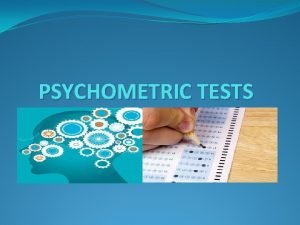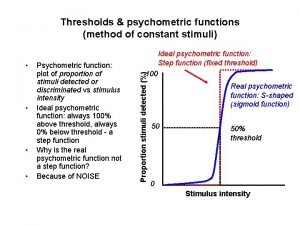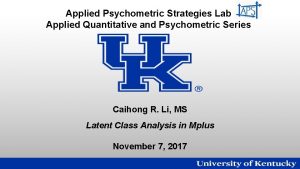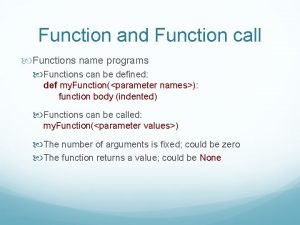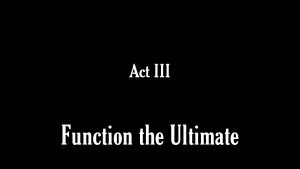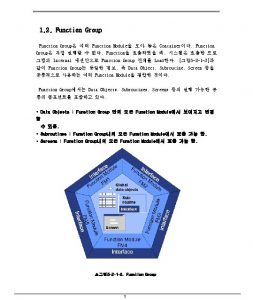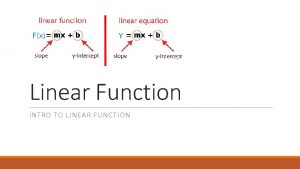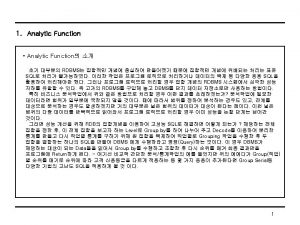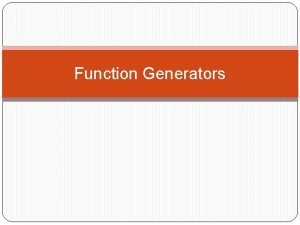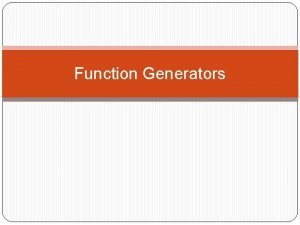Part 1 Psychometric Functions Psychometric Functions A function





















- Slides: 21

Part 1 Psychometric Functions

Psychometric Functions • A function is a rule for turning one number into another number. • In a psychometric function, we take one number (e. g. a quantified stimulus) and turn it into another number (e. g. the probability of a behavioral response). • By convention, the physical quantity is represented on the abscissa, and the behavioral response is represented on the ordinate.


Part 4: Psychometric Functions Linear Function = Sigmoidal Function = (Slope * X) + “Y-Intercept” 1_________ 1 + {( exp^ - Slope )^ - ( X - “X-Intercept”)}

Psychometric Functions About Slope

About Slope • Psychometric functions vary from each other in slope. • Steeper slopes, better discrimination, lower thresholds: Shallower slopes, worse discrimination, higher thresholds. • If your slope is infinite (i. e. , a step function), you have a “ceiling effect”. Your task is too easy for the subject. • If your slope is zero (i. e. , a flat function), you have a “floor effect”. Your task is too difficult for the subject. • Intermediate slopes are desirable, and allow you to dismiss objections that your subjects didn’t understand the task. (Perceptual limits, not “Conceptual” limits)




Psychometric Functions About X-Intercept

About X-Intercept • Psychometric functions vary from each other in X-intercept. • The X-intercept is an index of bias, and an index of the Point -of-Subjective-Equality (PSE). • To the extent that the X-intercept departs from the center of the abscissa (i. e. , the center of the range of stimuli being tested), there is bias. • The PSE is equal to the abscissal value (i. e. , the stimulus quantity) that is associated with the 50% ordinal value (the 50% response rate).




Psychometric Functions About Goodness-of-Fit

About Goodness-of-Fit • Psychometric functions vary from each other in “goodness of fit”. • To the extent data points (or their error bars) fall on or near the psychometric function, the fit is good. • The goodness of fit can be indexed by the correlation ( “r” statistic) between the data and the function. • If the fit (that is, the “r” statistic) is statistically greater than the would be expected by chance ( p < 0. 05 ), we can be confident in estimating thresholds and P. S. E. ’s from them.




Class Data From A Lab Exercise When in doubt, say “Longer”: slope = 1. 8 arbitrary units mid-point (PSE) = -0. 23 secs r statistic = 0. 99 When in doubt, say “Shorter”: slope = 2. 4 arbitrary units mid-point (PSE) = +0. 13 secs r statistic = 0. 99

Learning Check • On one plot, draw two psychometric functions that differ from each other only in slope (i. e. , discriminability). • On another plot, draw two psychometric functions that differ from each other only in mid-point (i. e. , PSE). • On a third plot, draw two psychometric functions that differ from each other only in ‘goodness of fit” (r stat).
 Charles spearman g factor
Charles spearman g factor Psychometrics
Psychometrics Engineering psychometric test
Engineering psychometric test Sales psychometric test
Sales psychometric test Psychometric approach to intelligence
Psychometric approach to intelligence Psychometric tests
Psychometric tests Ujian psikometrik sekolah menengah
Ujian psikometrik sekolah menengah Maksud pentaksiran psikometrik
Maksud pentaksiran psikometrik What is a situational judgement test
What is a situational judgement test Psychometric testing
Psychometric testing Addition symbol
Addition symbol Part to part ratio definition
Part to part ratio definition Part part whole
Part part whole Define technical description
Define technical description What are the three parts of the bar
What are the three parts of the bar The part of a shadow surrounding the darkest part
The part of a shadow surrounding the darkest part Two way anova minitab 17
Two way anova minitab 17 What are the parts of a seed?
What are the parts of a seed? What is the sepal function in a flower
What is the sepal function in a flower Anther function flower
Anther function flower Three pronged parts retriever
Three pronged parts retriever Microscope parts function
Microscope parts function

